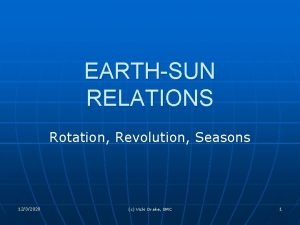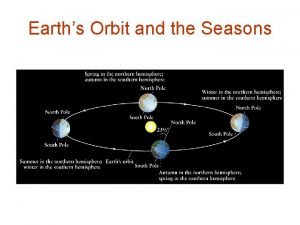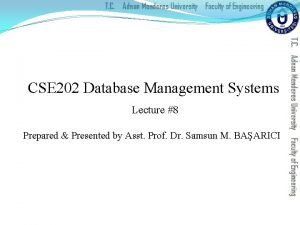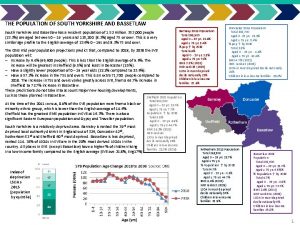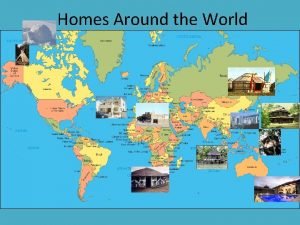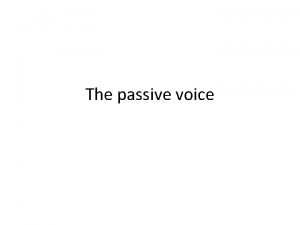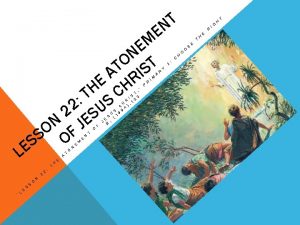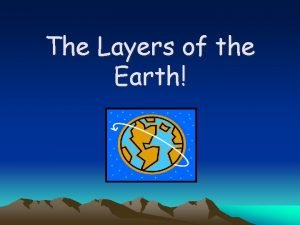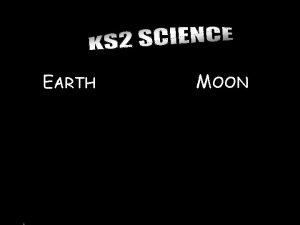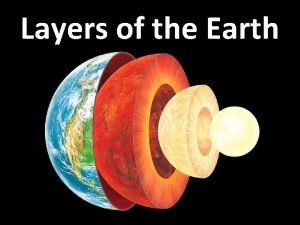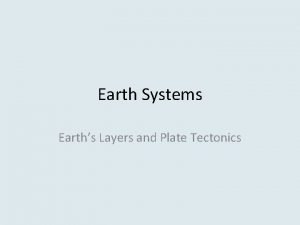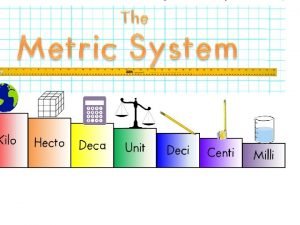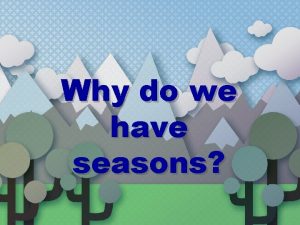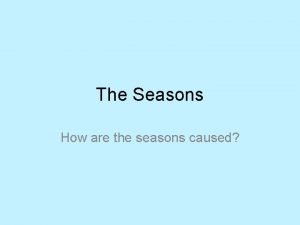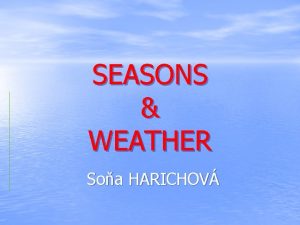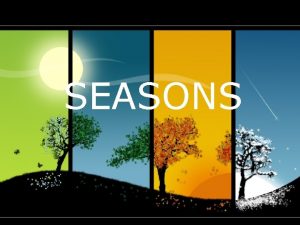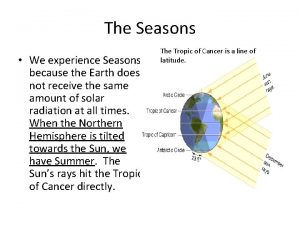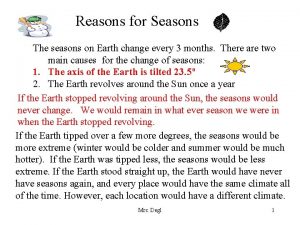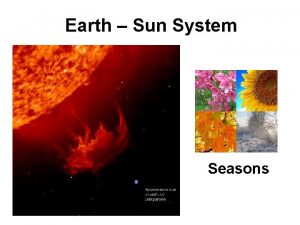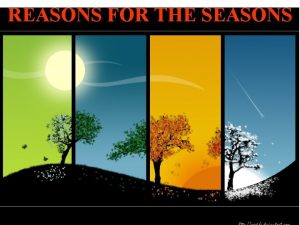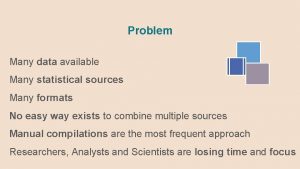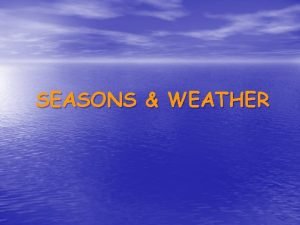Seasons on Earth Earth Seasons l Many people


































































- Slides: 66

Seasons on Earth

Earth Seasons l Many people believe that the seasons are caused by the Earth changing its distance to the Sun during its annual elliptical orbit.

Earth Seasons l This is wrong. In fact, the Earth is closest to the Sun in January, when it is coldest in the northern hemisphere.


So What Causes this Change in Temperature?


Earth Seasons l Instead, the seasons are caused by the Earth's axis of rotation not standing perpendicular to its plane of rotation around the Sun, but at an angle of 23. 4 o

Earth Seasons The Earth orbits the Sun in a counterclockwise direction. l The North Pole always points towards Polaris. l

Polaris


Earth Seasons The constant tilt of the Earth and our revolution is also evidenced by the changing of seasonal constellations. l Because we orbit the Sun the types of stars of the night sky change for different seasons. l



Summer sky constellations in the Northern Hemisphere

Winter sky constellations in the Northern Hemisphere

Earth Seasons The major effect of the Earth revolving around the Sun with a constant tilt is that the daily path of the Sun across the sky appears to change during the year. l This causes a change in the sunlight angle. l

Earth Seasons l The change in path not only effects the angle of sunlight (angle of insolation) but also the amount of time the Sun is above the horizon.


l http: //www. bing. com/videos/search? q=sea sons&&view=detail&mid=CFB 8234359 BA F 8 B 50 E 1 ECFB 8234359 BAF 8 B 50 E 1 E&&F ORM=VRDGAR

Angle of Insolation

Sun’s Light Rays l The sun is far enough away from the Earth that its energy reaches the Earth as virtually parallel rays.

This Sunlight is called Insolation l Insolation is defined as sunlight radiation that enters Earth’s atmosphere and hits the surface of the Earth.

Sun’s Light Rays l Because the Earth’s surface is curved the light rays strike different areas of the Earth at different angles.


This is Called: Angle of Insolation l What if the Earth was not an oblate spheroid but a Cube?


Angle of Insolation As the angle changes, it changes the amount of area on the Earth that receives that insolation (sunlight) l This is known as Intensity of Insolation l

Intensity of Insolation

Intensity of Insolation A measure of how direct the incoming solar radiation is on a certain location of Earth’s surface. Intensity will effect the temperature of the surface. If the sunlight is more intense, it will heat up the surface quicker. l

Changing Angles Earth’s round shape effects angles. l These changing angles result in the Earth receiving different amounts of energy at different locations (latitudes) l High latitude=low angle=low intensity=low temperature. l Low latitude=high angle=high intensity=high temperature. l

How the Angle Changes? l l l Angle and Intensity changes throughout the day. At sunrise the angle is very low. Low angle = Low intensity

Change in angle l l l At noon the sun is at its highest point in its path through the sky. This is known as Solar Noon High angle = High Intensity

Change in angle l l Again at sunset the sun’s rays are at a low angle. Low Angle = Low Intensity

Temperature changes during the day…. . Sunrise= low angle=low intensity=low temperature. l Solar Noon=high angle=high intensity=high temperature. l Sunset=low angle=low intensity=low temperature. l

Not so fast…. . The warmest part of the day is not Solar Noon and the coldest time of day is not sunrise/sunset. l The reason is because the Earth loses heat into the atmosphere as the day goes on. l This type of heat is called “radiation”. l This heat has a long wavelength called “Infrared Radiation”. l

Radiation

Daily Temperature Maximum As sun increases in altitude the surface of Earth heats up. l At solar noon the Sun is at highest altitude. l Solar noon is not the warmest time of the day. l 2 -3 pm is warmest time of day because Earth is now adding it’s own heat to atmosphere through a process called Radiation. l

Daily Temperature Minimum Sunrise and sunset is not the coldest time of the day. l Before sunrise is the coldest time of each day. l

Temperature Changes during the Year For the Northern Hemisphere: June 21 st=highest angle of insolation=highest solar intensity=longest path of sun=sun directly overhead at 23. 5 North of equator. December 21 st=lowest angle of insolation=lowest solar intensity=shortest path of sun=sun directly overhead at 23. 5 South of equator. l


Warmest Time of Year for the Northern Hemisphere…. . The warmest time of year is not on June 21 st when the sun has the most intensity. l It is in late July because the Earth is now giving off it’s own heat (radiation) and adding it to the atmosphere. l

Coldest Time of year for the Northern Hemisphere…. The coldest time of year is not December 21 st when the sun has the least intensity. l It is in late January because the Earth has lost all of its heat (radiation) that it gained since the summer. The Earth has “cooled off” making this the coldest time of the year. l

Other factors that affect how hot or cold Earth gets…. . Amount of snow (snow reflects light)=colder temperature. l Amount of Pollution (pollution traps heat)=warmer temperature. l Clouds (clouds during the day block sunlight)=colder temperature. l Clouds (clouds at night trap heat)=warmer temperature. l The trapping of heat in our atmosphere is called the Greenhouse effect!!!!!! l


Other factors that affect how hot or cold Earth gets…. . Dark colored surface (dark colors give off heat)=warmer temperature. l Closeness to water (water balances temperature)= cooler days and warmer nights. l


Further from water=warmer days and cooler nights.

Earth Seasons (NH Winter) For us in the Northern Hemisphere during winter months (Dec-March) the sun rises south of due east. l It sets south of due west. l This short arc gives us 43 N Latitude only about 9 hours of daylight on the winter solstice Dec 21 st. l

Earth Seasons This short arc is also a lower angle in the sky so that the maximum angle of insolation of the sun on the winter solstice is only 24. 5 o l Small angle = low intensity = low temperature. l

24. 5 o

Earth Seasons The winter solstice occurs when the noon time Sun is directly over latitude 23. 5 o S which is the Tropic of Capricorn. l This usually occurs for us on December 21 st or 22 nd. l For people at 23. 5 South this would be the longest day of their year (first day of summer). l


Earth Seasons After the winter solstice the path of the Sun moves northward (higher in our sky) until the Sun rises exactly east and sets exactly west. l This is the vernal (spring) equinox. l At this time the Sun reach’s a maximum angle of 48 o l

48 o

Earth Seasons During both equinoxes the Sun is directly over head on the equator at noon time. l The vernal equinox usually occurs on March 20 th or 21 st l


Earth Seasons The Sun’s path continues northward until the summer solstice on June 21 st. l On this day the Sun rises north of east and sets North of west creating a large path across the day time sky. l This results in about 15 hours of daylight with the Sun at a large maximum angle of 71. 5 o. l

Earth Seasons l The higher the angle of sunlight the greater the intensity of heat energy is absorbed, the warmer it is outside.

71. 5 o

Earth Seasons The summer solstice occurs for us when the Sun is directly over head at latitude 23. 5 o N (Tropic of Cancer) l This usually occurs around June 20 th or 21 st l


Earth Seasons From this point the Sun’s path starts to move south towards the equator. l When again the Sun rises exactly east and setting exactly west we have 12 hours of daylight. l This is the autumnal (fall) equinox. l It occurs for us on September 22 nd or 23 rd l


Earth Seasons l The southward movement of the Sun’s path continues till the winter solstice when the entire cycle starts over.

Earth Seasons Remember we are actually closer to the Sun during our (NH) winter and further from the Sun during our (NH) summer. l Aphelion= Away and Summer l Perihelion= Closer and Winter l

l http: //www. bing. com/videos/search? q=ang le+of+insolation&&view=detail&mid=F 4 D 2 CC 72 EBED 114 A 2 B 97 F 4 D 2 CC 72 EBED 11 4 A 2 B 97&&FORM=VRDGAR
 How many seasons in a year
How many seasons in a year Tongue twisters weather
Tongue twisters weather How seasons work
How seasons work Revolution
Revolution Seasons of the year earth's position
Seasons of the year earth's position Many buyers and sellers
Many buyers and sellers Er diagram in dbms
Er diagram in dbms Unary many to many
Unary many to many Erm and erd
Erm and erd Unary many to many
Unary many to many Contoh erd one to many
Contoh erd one to many Unary many to many
Unary many to many Many-to-many communication
Many-to-many communication Sqlbi many to many
Sqlbi many to many Ternary relationship database
Ternary relationship database Many sellers and many buyers
Many sellers and many buyers Dyslexia
Dyslexia How many people have dyslexia
How many people have dyslexia Upgrq
Upgrq How long ago was great wall of china built
How long ago was great wall of china built Roblox thicc avatar
Roblox thicc avatar Forensic science serial killers
Forensic science serial killers How many people speak russian
How many people speak russian Austrailia houses
Austrailia houses Ex 6 choose the correct item
Ex 6 choose the correct item The contest between businesses to win customers
The contest between businesses to win customers How many different three-letter initials can people have?
How many different three-letter initials can people have? Many people are unhappy with
Many people are unhappy with Why many people are with
Why many people are with The seeds of activism in 1972 resulted in
The seeds of activism in 1972 resulted in Many people assume that
Many people assume that How many people does it take to make a pencil
How many people does it take to make a pencil How many people live in austrailia
How many people live in austrailia Why many people are with
Why many people are with Say the colour not the word
Say the colour not the word Ali eats
Ali eats How many people
How many people Mounds
Mounds Cinquain family
Cinquain family Distinguish between group and team.
Distinguish between group and team. How many people are
How many people are For many years people have wondered
For many years people have wondered Tea is popular many people in the world
Tea is popular many people in the world Mediterranean climate in us
Mediterranean climate in us Tim too many young people are
Tim too many young people are Many people
Many people New jerusalem
New jerusalem Two types of people media are
Two types of people media are Black eyed peas where is the love lyrics
Black eyed peas where is the love lyrics Recovery community
Recovery community Justpeople
Justpeople How many layers are there in the earth
How many layers are there in the earth Is moon bigger than earth
Is moon bigger than earth What are the 3 layers of earth
What are the 3 layers of earth How many layers of the earth
How many layers of the earth Thick awe loved hoot he
Thick awe loved hoot he Not so long ago, people
Not so long ago, people What causes seasons rotation or revolution
What causes seasons rotation or revolution Why do we experience seasons
Why do we experience seasons Seasons in czech
Seasons in czech Summer comes after spring
Summer comes after spring The wire season themes
The wire season themes Why seasons
Why seasons What does clove of seasons mean
What does clove of seasons mean Liturgical year
Liturgical year S
S English
English



